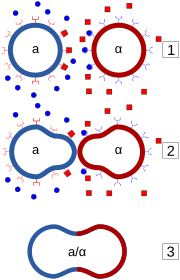I’ve been wondering about starting my own little yeast-breeding operation. I haven’t yet figured out where you can by the necessary teeny, tiny yeast-sized versions of the Implements of Extremely Impolite Probing that breeders of other species use, but even before that, I need to understand yeast reproduction better in the first place.
I had gotten an impression from some of the stuff that I’d read in a Genetics textbook and online that yeasts were normally haploid, and only became diploid briefly during mating (you see, when an “?” haploid yeast cell and an “a” haploid yeast cell fall in love, sometimes they’ll…). On the other hand, while reading a review of yeast virology[1], the author explicitly wrote that yeast cells are normally diploid. How to resolve this issue? Plus, I was wondering how, if I happened to have a pure culture of a haploid yeast, how could I tell if it was “a” or “?”?
I recently realized that there was one Dr. Bryk in the department where I work who specifically researches yeast chromosomes…so I asked her…
 Sure enough, she confirmed that under normal circumstances, yeast cells are in a diploid state. You get them to become haploid spores by starving them. As for finding out what “sex” a haploid culture is, I was expecting some sort of funky molecular trick, but if you have a known “a” or “?” culture, you can just mix it with your unknown culture and watch for yeast-porn under the microscope. If you mix your unknown with a known, and you spot any “Schmooing” going on, you know your unknown is the opposite of your “known”.
Sure enough, she confirmed that under normal circumstances, yeast cells are in a diploid state. You get them to become haploid spores by starving them. As for finding out what “sex” a haploid culture is, I was expecting some sort of funky molecular trick, but if you have a known “a” or “?” culture, you can just mix it with your unknown culture and watch for yeast-porn under the microscope. If you mix your unknown with a known, and you spot any “Schmooing” going on, you know your unknown is the opposite of your “known”.
I did some more poking around, though, and there’s yet another complication. Sure, they’re shamelessly promiscuous, yeast-herpes infected hermaphroditic drunks peeing cancer into our beer. In addition to that, just when you think you’ve got a group of all one “sex”…they can change from one to the other.
It turns out the section of the Saccharomyces genome that determines the mating type has copies of both other mating types around it. In some conditions, the yeast generates an enzyme that cuts the section of DNA that determines the mating type. Other enzymes then come along and replace the damaged section with a copy from one of the mating-type gene copies – usually the opposite of the one it had originally for some reason. I haven’t yet figured what what triggers this under normal circumstances. However it looks like if you expose Saccharomyces cerevisiae to radiation or other DNA-damaging events, instead of glowing or getting superpowers like clean, decent organisms, this can sometimes trigger the yeasts’ “sex change”[2].
Man…yeast-breeding seems a lot more complicated than the “Insert Tab ‘A’ into Slot ‘B'” approach used for boring old soft-celled multicellular organisms.
[1] Wickner RB: “Yeast virology.” FASEB J. 1989 Sep;3(11):2257-65. (Pubmed entry and link to full text here)
[2] Schiestl RH.:”DNA-damaging agents show different kinetics in induction of heterothallic mating-type switching during growth after treatment in yeast.” Mutat Res. 1989 Dec;227(4):269-74. (I’ve only seen the abstract on this one…)
Schmooing. It’s fun to say, it’s fun to see.
I’ll see it one of these days. One of these days I’ll finally actually have my own microscope.
And a pony…